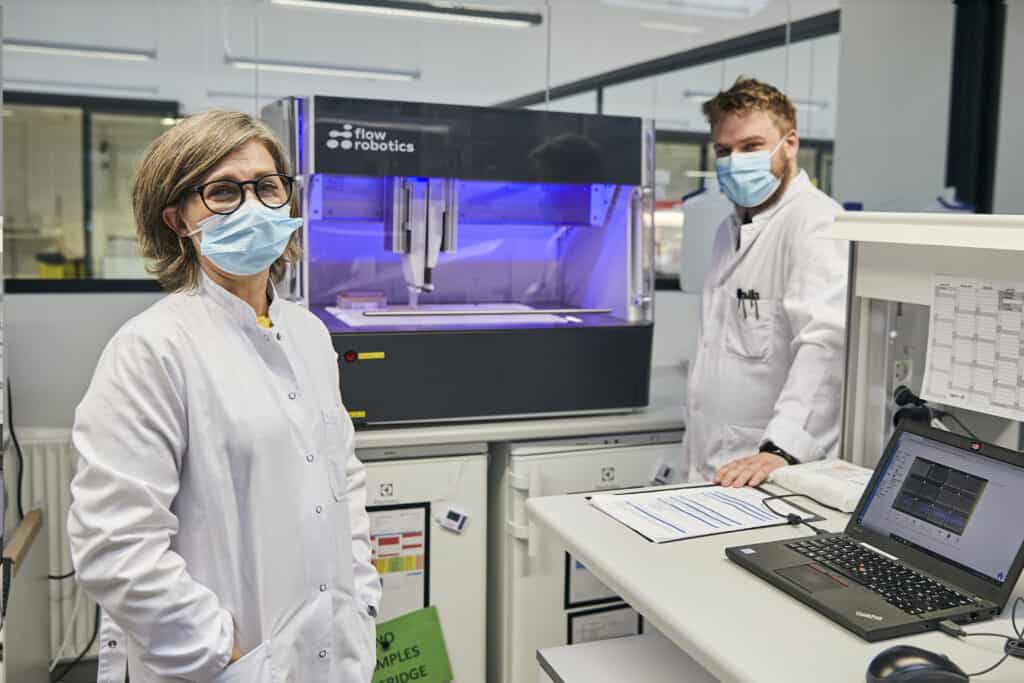A Specialist’s Guide to Automated Liquid Handling
By harnessing the power of automation, you can achieve unparalleled efficiency, accuracy, and productivity. This is imperative for remaining at the forefront of science and innovation.
If you’re already specialized in automation, you’ll be well aware of the advantages of liquid handlers and how they can benefit your lab. Perhaps you’ve even decided to automate your liquid handling processes.
In that case, we’ll get straight to the point and address how to implement automated liquid handling successfully.
You can start by outlining strategies for the two vital points that often differ from lab to lab.
Ask yourself the following:
- How do you create an automated workflow that feels intuitive to your users?
- Which automation solution is the right fit in your lab?
Creating an intuitive workflow with automated liquid handling
Creating an intuitive and efficient workflow with automated liquid handling is essential for getting maximum value out of your automation solution.
It is vital that the staff is not only able to use the technology, but actually wants to use it.
Designing the workflow in collaboration with the end-users is key to reaching that point. After all, people think differently and structure their work differently.
There is no universal recipe for getting there, but we have found that good communication goes a very long way. When you cultivate a culture where humans and robots can work effortlessly side-by-side it usually turns out great.
When Danish Biomarker company, Nordic Bioscience, automated liquid handling with the flowbot® ONE, they handled it like so:
“We have had meetings and workshops with the technicians and described the purpose of optimizing the process of performing manual tests in the lab, reducing pipetting injuries and reducing tech-to-tech variation as well as increasing the throughput,” says Kishwar Musa, Director of the Clinical Lab, Nordic Bioscience.
What they got in return was an efficient lab where the pipetting robot, flowbot® ONE, contributed to a better workflow alongside the staff.

5 Questions to ask yourself
You’ll probably already know that there is a large selection of liquid handlers on the market, which all have different values. You probably also know that it is super important to get an instrument that fits your needs.
When choosing the right instrument, ask yourself the following 5 questions:
1. How often do I change my protocol?
Some labs need to process thousands of samples in the exact same way every single day. These labs will often benefit from a large automated liquid handling workstation.
Other labs are smaller and need to stay agile and open to change.
These labs will benefit from a flexible and user-friendly system.
Their ideal robot is fully adjustable by the user, enabling it to evolve alongside the lab and, thus, future-proof it.
For example, the public health laboratory, Certe, uses a flowbot® ONE to detect both Influenza, RS-virus and COVID-19 as needed.

The flowbot® ONE has a vital role in future-proofing our lab because it’s always ready to lend a hand when we have to perform high-volume respiratory testing.
2. Do I need to scale up or down in the future?
Scalability is a major factor when choosing automated liquid handling.
Again, a large, automated workstation is great when you are running many tests continuously.
But if your number of samples tend to vary, consider getting a more agile instrument that is easily adjustable to either high or low volume testing.
Think back to when the pandemic hit in 2020, and imagine the difference it could have made if you were able to scale up your testing capacity immediately without making major changes to your workflow. A smaller and flexible instrument would allow you to do that.
3. Is it compatible with my other instruments?
Finding the perfect fit is everything.
It perhaps goes without saying that any automation solution should be able to work smoothly with your other instruments – and people for that matter.
There is no fixed roadmap for this as each lab is unique, but we always recommend making as few alterations to your current setup as possible.
In general, smaller and agile instruments are often more likely to fit in as they are designed to serve more than a single purpose.
The flowbot® ONE, for example, has an open API to integrate on-deck and external devices.
4. Who are the end-users?
You need to consider who the users are and which skillsets they have.
If you can answer “yes” to the following questions, you should look at a system that is designed to be user-friendly and flexible:
- Are the users untrained in programming?
- Will several different people operate it?
- Will more than one project use the same robot?
Imagine the repercussion a single programming error can have if it has many different users.
We ensure that no mistakes occur by having guided template programs and a fool-proof user-interface.
Luckily the effort seems to pay off, and at Copenhagen University they use the same flowbot® ONE for 15 different NGS projects.
5. How much space do I have in the lab?
For many, lack of lab space is a perpetual problem.
But luckily, there’s a simple solution.
If you lack lab space, simply get a tabletop robot that can be placed in a corner. This will also save you the floor space your lab technicians occupy when performing manual pipetting.
Our solution
We wanted to create automated liquid handling that was intuitive and felt good to use. We also wanted to create something the was highly scalable and easily adjustable, enabling labs to bring it into their future endeavors.
To achieve that, we designed the market’s most user-friendly software and built our high-quality hardware up around that. Then we added a touch of Danish design.
Flowbot® ONE is an affordable solution with a full set of advanced features that anyone can learn to use in just one hour. Its browser-based software can be programmed with drag & drop, meaning that you don’t need programming skills to operate it.
With highly flexible software and plug & play on any of the 12 positions on the deck, we ensure that you can smoothly switch between protocols and your lab can stay agile.
And if you need a hand, we offer local service and support throughout the world.
Flowbot® ONE is available with different accessories such as UV light, a HEPA filter, and the super-efficient sample tracking solution, ScanID.
